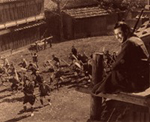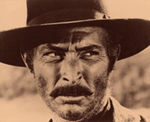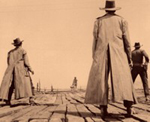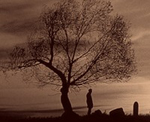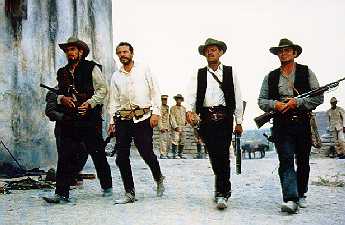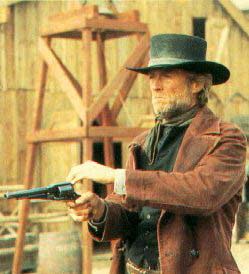Chapter V: Legacies
The steady decline in Western production (from one hundred and thirty features made in 1950 to eleven in 1963)2 was reversed in the mid-sixties (twenty one being made in 1964, twenty two in 1965), and another revival occurred as the seventies dawned (peaking at twenty five features in 1972). Mitchell asserts that Leone reinvigorated the genre,3 and Slotkin identifies the birth of a 'formalist' breed of Western in the early seventies (abstract 'fairy tale' films such as Eastwood`s High Plains Drifter (1972)), which he attributes to the legacy of Leone.4 Slotkin`s study of the 1970`s Western revivals also outlines a clear trend toward historical revisionism - White America`s values are re-examined in many post-Leone Westerns from Arthur Penn`s Little Big Man (1970) to Kevin Costner`s Dances With Wolves (1990). Leone certainly succeeded in subverting Hollywood`s mythology, but it would be hard to argue that he alone opened up 'history' for reappraisal. Ford`s Cheyenne Autumn (1964) had re-addressed native grievances, and Slotkin rightly points out a wider social trend in late 1960s and early 1970s America. Race riots and Vietnam had brought into question the myth of White America`s conquering of 'savagery,' and Indians made convenient substitutes for the Vietnamese. John Wayne`s championing of American values during Vietnam did nothing to win over the new youth culture to the traditional Western, so Leone`s popularity would appear to be symptomatic of a shift in the American zeitgeist, more than a catalyst for transformation. Stylistically, however, the Western showed signs of influence by Leone. Predictions of the genre`s death had once again proved premature, and Hollywood studios took notice of his popularity. Ted Post`s Hang `Em High (1968) cashed in on the 'Spaghetti' craze with a brutal revenge plot and a starring role for Clint Eastwood, but it was a tepid imitation. More significantly, Sam Peckinpah was now able to indulge his penchant for ultra-violent studies of bloodshed - a point not missed by an over-proud Leone: In retrospect,
I can see that A Fistful of Dollars heralded the beginnings of
a new Certainly, post-Leone Hollywood allowed more violence on the screen, but this is as far as is goes - Peckinpah`s Westerns, while violently narrating the twilight of the Old West, retain a romantic sense that, while progress is inexorable, the old values of comradeship are noble. The Wild Bunch (1969) shows the final days of ageing bandits heading for doom, and Pike Bishop (William Holden) sums up Peckinpah`s admiration for the old values: 'When you side with a man you stay with him, and if you can`t do that you`re like some animal - you`re finished.' Blondie, Tuco and Angel Eyes would have sneered at such sentimentality.
Peckinpah's wild bunch face their doom together
Leone`s most significant influence on the Hollywood Western was in bringing Clint Eastwood to stardom. Acting under Don Siegel in Coogan`s Bluff (1968), Two Mules for Sister Sarah (1969) and The Beguiled (1970), Eastwood honed his own directorial skills. By 1971 he was the number one box office draw in Hollywood, and he embarked on Western projects exploring the persona that had launched him. His first Western as director - High Plains Drifter (1972) - is an explicit homage to Leone, as Eastwood`s lone angel of death rides into a guilt-ridden town and, after exacting an horrific hell and brimstone vengeance, renames the town 'Hell.' As if to drive the debt to Leone home, the chief villain pleads 'Who are you?' at the point of death! Eastwood certainly changed the Western in the 1970s, his lone avengers (evolved directly from Leone) taking the Hollywood Western further and further away from the John Wayne model. Michael Coyne accuses Eastwood of 'bastardizing'6 the genre, but Slotkin identifies Eastwood`s deft manipulation of the myth`s changing trends: Eastwood`s persona
is honed like a razor on the negative example of John Wayne -
Unforgiven was dedicated to Don Siegel, and to Leone, who had died in 1989. It displays a knowing study both of the nature of myth (a dime novelist follows a legendary gunslinger before discovering the less than heroic reality) and of Eastwood`s established persona, as his retired killer struggles to repress his past violence, which bubbles under the surface before exploding in ruthless gunsmoke at the end. 1990s Westerns, it is true, have displayed a conscious debt to Leone`s vision (Sam Raimi`s The Quick and the Dead (1994) depicting a female 'No Name' blasting through nooses and opponents in a quest to avenge her family) but generally, the revivals of the Western in the 1970s and the 1990s have centred around de-mythologising the West, whether it be to re-address native grievances or to explode cherished myths (Wyatt Earp being brought down to earth in both George P. Cosmatos`s Tombstone (1993) and Lawrence Kasdan`s Wyatt Earp (1994)). Leone, as I have established, explodes historical myth self-consciously to build his own, ancient, myth, so perhaps his legacy also lies outside the historically specific 'West.' Eastwood brought his ruthless gunfighter to the modern city in Siegel`s Dirty Harry (1971), and mythic structures that had hitherto been the preserve of the Western expanded into other genres more and more as the 1970s progressed. Slotkin highlights9 Martin Scorsese`s Taxi Driver (1976) as a mythologised urban loner, and George Lucas`s Star Wars (1977) famously adapts a Western story of 'a long time ago' to 'a galaxy far, far away.' I suggest that Leone, as a major part of the larger 1960s tendency to question accepted cultural myths, helped 'release' the myth from its historical shackles. Other genres blossomed, taking away the Western`s allegorical and mythic resonance more and more - Vietnam films (such as Apocalypse Now (1979)) continually narrate a journey into savagery and a questioning of 'civilised' values, and Mitchell writes10 that the 1960s Westerner became the 1980s lone action hero in Ridley Scott`s Blade Runner (1982), James Cameron`s The Terminator (1984) and Sylvester Stallone`s Rambo series. Leone cannot therefore be said to have breathed new life into the Western, as much as into cinema, by freeing the myth from the genre. His style, however, won over film goers who would not otherwise have cared for Westerns, but by way of his films have come to acknowledge the genre`s power - myself included. If Leone did put another nail in the Western`s coffin, he gave it a glorious send-off.
Footnotes1. Frayling, Sergio Leone,
p.299. |

